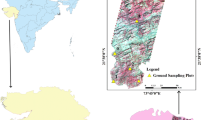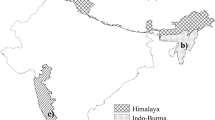Abstract
Remote sensing offers fast and reliable technique to map the variation in plant diversity and distribution at different scales. Using 891 geo-tagged ground sampled point collected for the Western Ghats, India from a national level study on biodiversity characterization. We analyzed the distribution of plant species with respect to the satellite derived vegetation indices. The moderate resolution imaging spectroradiometer derived vegetation products, i.e., normalized difference vegetation index (NDVI), enhanced vegetation index (EVI), fraction of absorbed photosynthetically active radiation (fPAR), leaf area index (LAI), and surface reflectance (SR-645nm and SR-858nm) were fitted to suitable regression curves with respect to plant species richness where NDVI demonstrated the best fit (R2 = 0.07); while fPAR showed (R2 = 0.08) better relation with woody species richness. We observed positive but weak correlation for all the biophysiological proxies with species richness in the forests of Western Ghats. The annual pattern of correlation faired than seasonal (i.e., post-monsoon) between biophysical variables and species richness, while the woody subset of the species richness demonstrated marginally better relation at annual scale. The range of each biophysical proxy varied from medium to high, indicating higher vegetation strength. The species richness trend increased linearly for NDVI and EVI. The positive correlation showed by fPAR and LAI could be due to varied canopy architecture of the Western Ghats forests. Utility of fine resolution spatio-temporal data could render better understanding of species richness pattern using biophysical proxies, and thereby, help in long-term biodiversity monitoring.







Similar content being viewed by others
References
Levin N, Shmida A, Levanoni O, Tamari H, Kark S (2007) Predicting mountain plant richness and rarity from space using satellite-derived vegetation indices. Divers Distrib 13:692–703
Phillips LB, Hansen AJ, Flather CH, Robison-Cox J (2010) Applying species–energy theory to conservation: a case study for North American birds. Ecol Appl 20:2007–2023
Tucker CJ, Pinzon JE, Brown ME, Slayback DA, Pak EW, Mahoney R, Vermote EF, El Saleous N (2005) An extended AVHRR 8-km NDVI dataset compatible with MODIS and SPOT vegetation NDVI data. Int J Remote Sens 26:4485–4498
Diamond J (1988) Factors controlling species diversity: overview and synthesis. Ann Mo Bot Gard 75:117–129
Carlson KM, Asner GP, Hughes RF, Ostertag R, Martin RE (2007) Hyperspectral remote sensing of canopy biodiversity in Hawaiian lowland rainforests. Ecosystems 10:536–549
Colwell RK, Coddington JA (1994) Estimating terrestrial biodiversity through extrapolation. Philos Trans R Soc B 345:101–118
Nagendra H (2001) Using remote sensing to assess biodiversity. Int J Remote Sens 22:2377–2400
Rey-Benayas JM, Pope KO (1995) Landscape ecology and diversity patterns in the seasonal tropics from Landsat TM imagery. Ecol Appl 5:386–394
Gould W (2000) Remote sensing of vegetation, plant species richness, and regional biodiversity hotspots. Ecol Appl 10:1861–1870
Rocchini D (2007) Effects of spatial and spectral resolution in estimating ecosystem alpha-diversity by satellite imagery. Remote Sens Environ 3:423–434
Lauver C (1997) Mapping species diversity patterns in the Kansas shortgrass region by integrating remote sensing and vegetation analysis. J Veg Sci 8:387–394
Gessner U, Machwitz M, Conrad C, Dech S (2013) Estimating the fractional cover of growth forms and bare surface in savannas. A multi-resolution approach based on regression tree ensembles. Remote Sens Environ 129:90–102
Viña A, Tuanmu MN, Xu W, Li Y, Qi J, Ouyang Z, Liu J (2012) Relationship between floristic similarity and vegetated land surface phenology: implications for the synoptic monitoring of species diversity at broad geographic regions. Remote Sens Environ 121:488–496
Morán-Ordóñez A, Suárez-Seoane S, Elith J, Calvo L, de Luis E (2012) Satellite surface reflectance improves habitat distribution mapping: a case study on heath and shrub formations in the Cantabrian Mountains (NW Spain). Divers Distrib 18:588–602
Puzachenko YG, Sandlersky RB, Sankovski AG (2016) Analysis of spatial and temporal organization of biosphere using solar reflectance data from MODIS satellite. Ecol Model 341:27–36
Jackson TJ, Daoyi C, Michael C, Fuqin L, Martha A, Charles W, Paul D, Hunt ER (2004) Vegetation water content mapping using Landsat data derived normalized difference water index for corn and soybeans. Remote Sens Environ 92:475–482
Rocchini D, Chiarucci A, Loiselle SA (2004) Testing the spectral variation hypothesis by using satellite multispectral images. Acta Oecol 26:117–120
Ozkan UY, Ozdemir I, Saglam S, Yesil A, Demirel T (2016) Evaluating the woody species diversity by means of remotely sensed spectral and texture measures in the urban forests. J Indian Soc Remote Sens 44:687–697
Bawa K, Rose J, Ganeshaiah KN, Barve N, Kiran MC, Umashanker R (2002) Assessing biodiversity from space: example from Western Ghats, India. Conserv Ecol 6:1–7
Seto KC, Fleishman E, Fay JP, Betrus CJ (2004) Linking spatial patterns of bird and butterfly species richness with Landsat TM derived NDVI. Int J Remote Sens 25:4309–4324
Phillips LB, Andrew JH, Curtis HF (2008) Evaluating the species energy relationship with the newest measures of ecosystem energy: NDVI versus MODIS primary production. Remote Sens Environ 112:4381–4392
John R, Jiquan C, Nan L, Ke G, Cunzhu L, Yafen W, Asko N, Keping M, Xingguo H (2008) Predicting plant diversity based on remote sensing products in the semi-arid region of Inner Mongolia. Remote Sens Environ 112:2018–2032
Huete A, Didan K, Miura T, Rodriguez EP, Gao X, Ferreira LG (2002) Overview of the radiometric and biophysical performance of the MODIS vegetation indices. Remote Sens Environ 83:195–213
Peng D, Chaoyang W, Cunjun L, Xiaoyang Z, Zhengjia L, Huichun Y, Shezhou L, Xinjie L, Yong H, Bin F (2017) Spring green-up phenology products derived from MODIS NDVI and EVI: intercomparison, interpretation and validation using National Phenology Network and AmeriFlux observations. Ecol Ind 77:323–336
Hilker T, Lyapustin AI, Hall FG, Myneni R, Knyazikhin Y, Wang Y, Tucker CJ, Sellers PJ (2015) On the measurability of change in Amazon vegetation from MODIS. Remote Sens Environ 166:233–242
Lafage D, Jean S, Anita G, Jan-Bernard B, Julien P (2014) Satellite-derived vegetation indices as surrogate of species richness and abundance of ground beetles in temperate floodplains. Insect Conserv Divers 7:327–333
Waring RH, Coops NC, Fan W, Nightingale JM (2006) MODIS enhanced vegetation index predicts tree species richness across forested ecoregions in the contiguous USA. Remote Sens Environ 103:218–226
Shabanov NV, Wang Y, Buermann W, Dong J, Hoffman S, Smith GR, Tian Y, Knyazikhin Y, Myneni RB (2003) Effect of foliage spatial heterogeneity in the MODIS LAI and FPAR algorithm over broadleaf forests. Remote Sens Environ 85:410–423
Saatchi S, Buermann W, TerSteege H, Mori S, Smith TB (2008) Modeling distribution of Amazonian tree species and diversity using remote sensing measurements. Remote Sens Environ 112:2000–2017
Wang Y, Woodcock CE, Buermann W, Stenberg P, Voipio P, Smolander H, Häme T, Tian Y, Hu J, Knyazikhin Y, Myneni RB (2004) Evaluation of the MODIS LAI algorithm at a coniferous forest site in Finland. Remote Sens Environ 91:114–127
Nagendra H, Gadgil M (1999) Satellite imagery as a tool for monitoring species diversity: an assessment. J Appl Ecol 36:388–397
Singh TP, Das S (2014) Predictive analysis for vegetation biomass assessment in Western Ghat region (WG) using geospatial techniques. J. Indian Soc. Remote Sens. 42:549–557
Nagendra H, Ghate U (2003) Landscape ecological planning through a multi-scale characterization of pattern: studies in the Western Ghats, South India. Environ Monit Assess 87:215–233
Kumar A, Uniyal SK, Lal B (2007) Stratification of forest density and its validation by NDVI analysis in a part of western Himalaya, India using Remote sensing and GIS techniques. Int J Remote Sens 28:2485–2495
Pau S, Thomas WG, Elizabeth MW (2012) Dissecting NDVI–species richness relationships in Hawaiian dry forests. J Biogeogr 39:1678–1686
Tonkin JD, Bogan MT, Bonada N, Rios-Touma B, Lytle DA (2017) Seasonality and predictability shape temporal species diversity. Ecology 98:1201–1216
Bender I, Kissling WD, Böhning-Gaese K, Hensen I, Kühn I, Wiegand T, Dehling DM, Schleuning M (2017) Functionally specialised birds respond flexibly to seasonal changes in fruit availability. J Anim Ecol 86:800–811
Roy PS, Behera MD, Murthy MS, Roy A, Singh S, Kushwaha SP, Jha CS, Sudhakar S, Joshi PK, Reddy CS, Gupta S et al (2015) New vegetation type map of India prepared using satellite remote sensing: comparison with global vegetation maps and utilities. Int J Appl Earth Obs Geoinf 39:142–159
Gunawardene NR, Daniels DA, Gunatilleke IA, Gunatilleke CV, Karunakaran PV, Nayak GK, Prasad S, Puyravaud P, Ramesh BR, Subramanian KA, Vasanthy G (2007) A brief overview of the Western Ghats-Sri Lanka biodiversity hotspot. Curr Sci 93:1567–1572
Pascal JP, Ramesh BR, DE Franceschi D (2004) Wet evergreen forest types of the south Western Ghats, India. Trop Ecol 45(2):281–292
Ramesh BR, Menon S, Bawa KA (1997) vegetation-based approach to biodiversity gap analysis in Agasthyamalai region, Western Ghats, India. Ambio 28:529–536
Chitale VS, Behera MD, Roy PS (2014) Future of endemic flora of biodiversity hotspots in India. PLoS ONE 9:1–15
Roy PS, Kushwaha SPS, Murthy MSR, Roy A, Kushwaha D, Reddy CS, Behera MD, Mathur VB, Padalia H, Saran S, Singh S, Jha CS, Porwal MC (2012) Biodiversity Characterisation at landscape level: national assessment. Indian Institute of Remote Sensing, Dehradun, p 140. ISBN 81-901418-8-0
Hobi ML, Dubinin M, Graham CH, Coops NC, Clayton MK, Pidgeon AM, Radeloff VC (2017) A comparison of Dynamic Habitat Indices derived from different MODIS products as predictors of avian species richness. Remote Sens Environ 195:142–152
Wardlow BD, Stephen LE (2010) A comparison of MODIS 250-m EVI and NDVI data for crop mapping: a case study for southwest Kansas. Int J Remote Sens 31:805–830
Knyazikhin Y, Martonchik JV, Myneni RB, Diner DJ, Running SW (1998) Synergistic algorithm for estimating vegetation canopy leaf area index and fraction of absorbed photosynthetically active radiation from MODIS and MISR data. J Geophys Res 103:32257–32277
Tian Y, Zhang Y, Knyazikhin Y, Myneni RB, Glassy JM, Dedieu G, Running SW (2000) Prototyping of MODIS LAI and FPAR algorithm with LASUR and LANDSAT data. IEEE Trans Geosci Remote Sens 38:2387–2401
ESRI, ESRI, Redlands CA (2004) ArcGIS, New York
Tim Ormsby (2004) Getting to know ArcGIS desktop: basics of ArcView, ArcEditor, and ArcInfo. ESRI Inc., Redlands
Serbin SP, Douglas EA, Stith TG (2013) Spatial and temporal validation of the MODIS LAI and FPAR products across a boreal forest wildfire chronosequence. Remote Sens Environ 133:71–84
Author information
Authors and Affiliations
Corresponding author
Rights and permissions
About this article
Cite this article
Mahanand, S., Behera, M.D. Relationship Between Field-Based Plant Species Richness and Satellite-Derived Biophysical Proxies in the Western Ghats, India. Proc. Natl. Acad. Sci., India, Sect. A Phys. Sci. 87, 927–939 (2017). https://doi.org/10.1007/s40010-017-0460-8
Received:
Revised:
Accepted:
Published:
Issue Date:
DOI: https://doi.org/10.1007/s40010-017-0460-8




